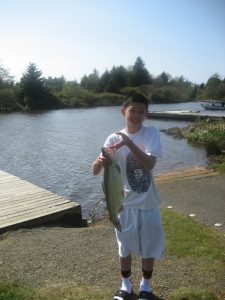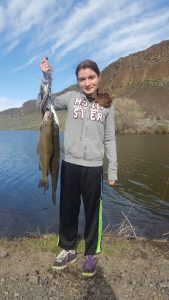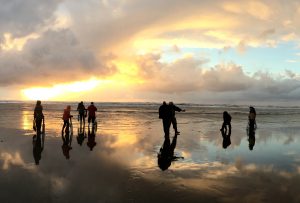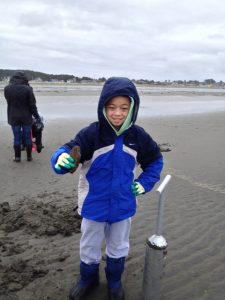Expect top-notch trout fishing in the weeks ahead, and first of season razor clam digs approved Leave a reply
While the weather may be cooling down, the fall trout fishing opportunities are actually starting to heat up.
WDFW is looking at planting around 2,000 rainbow trout in various Snohomish County lakes and 1,700 will be headed into a few Skagit County lakes on top of the 2,400 annually planted each fall into Beaver Lake near Issaquah.
“There will be a fall fishing promotion where some lakes in our (Puget Sound) region will be getting some plants of thousands of rainbow trout,” said Justin Spinelli, a WDFW regional biologist in Mill Creek.
Spinelli says Beaver Lake will receive three allotments of 700 to 800 rainbow trout averaging 1 ½ pounds apiece on the third week in October, November and December. These trout are part of an educational display at WDFW’s Issaquah Hatchery.
“Instead of dumping all the fish in at one time we have spread out the plants to make the fishery less of a “circus-like” atmosphere, and will allow folks to catch fish well into January and beyond,” Spinelli said of the year-round 60.3-acre lake located on the Issaquah Plateau. “We raise these fish for anglers to have fun in the fall to catch them.”
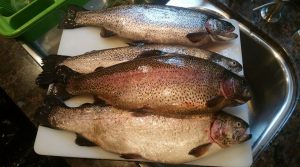
This batch of jumbo-sized rainbow trout were caught at Beaver Lake last fall by Tom Quinn of Issaquah. Look for plenty of these to be swimming around in the weeks ahead!
With the recent WDFW fishing rule simplification changes for statewide lakes, Beaver now has reverted back to the standard five-trout daily limit with no minimum size limit. The shoreline access is fairly limited at Beaver so it is best fished by a small boat or watercraft.
The WDFW’s access site is most easily reached by way of East Beaver Lake Drive Southeast, off Southeast 24th Street in the city of Sammamish.
Parking for vehicles and boat trailers is limited at Beaver, and a valid WDFW Vehicle Access Pass or Discover Pass must be visible in vehicles parked at the access site.
Beaver isn’t the only lake that will garner attention in the months ahead as WDFW is also planting thousands of trout in northern Puget Sound regional lakes.
They include Gissburg Ponds North and South; Lake Tye in Monroe; Grandy Lake near Concrete; Clear Lake south of Sedro-Woolley; and Lake Campbell south of Anacortes.
“We will also stock Lake Goodwin (northwest of Marysville) in December and this has developed into a nice winter trout fishery with plump rainbow trout,” Spinelli said. “These fish will produce action for anglers well into the winter-time.”
Trout chasers shouldn’t overlook lakes planted with more than 2-million fish last spring for opening day too.
“We’ve also got a lot of trout leftover from opening day (last April) and these fish have been growing all summer-long and will produce good fishing until the season closes on Oct. 31,” Spinelli said.
Spinelli says he’s heard decent reports from lakes like Langlois, Sixteen and Ki just to name a few.
Other lakes worth a second look are Cottage, Pine, Wilderness, Aberdeen, Steel, Panther, Bay, McMurray, Stickney, Storm, Summit, Cain, Padden and Toad.
The WDFW Statewide Trout Fishing Derby, which is open through Oct. 31, has been pretty successful, according to Spinelli.
“This is the third year of the derby, and while we’ve seen a lot of tags turned in for prizes there are still a lot of tags out there on fish for anglers to catch,” he said.
Anglers can find the list of more than 100 lakes with tagged fish by going to https://fishhunt.dfw.wa.gov/Home/FishingDerby.
The effort to boost fall/winter trout fishing will also include stocking some southwestern Washington lakes for the Nov. 24 Black Friday opener, which offers anglers the opportunity to skip the shopping malls, get outside and enjoy fishing on the day after Thanksgiving.
Anglers should follow the WDFW on Twitter or Facebook or go to http://wdfw.wa.gov.
Dig this! Coastal razor clam season opener begins on Oct. 11-13
The first autumn coastal razor clam digs of the 2018-19 season were approved to begin on Oct. 11 (minus-0.6 feet at 8:58 p.m.) at Twin Harbors and Mocrocks; Oct. 12 (-0.3 at 9:41 p.m.) at Twin Harbors and Copalis; Oct. 13 (0.1 at 10:26 p.m.) at Twin Harbors and Mocrocks.
All digs are reliant on testing for marine toxins known as domoic acid — a natural marine toxin produced by certain types of marine algae. Clams with high amounts of marine toxins can be harmful or even fatal if consumed in sufficient quantities.
Domoic acid levels must remain under the 20 parts-per-million cutoff range in order for WDFW to allow digging on beaches. Latest sample test results from Sept. 26 showed all beaches were at 1-ppm.
Razor clam populations look solid at Twin Harbors, Copalis and Mocrocks beaches according to summer assessment surveys taken by WDFW.
In all the 2018-19 total allowable catch share of razor clams is 333,557 with a projected daily harvest of 60,000 at Long Beach; 1,377,125 with 35,000 at Twin Harbors; 860,768 with 50,000 at Copalis; 1,508,774 with 40,000 at Mocrocks; and 777,386 at Kalaloch.
Digging in the 2017-18 season generated a harvest of 2.7-million razor clams for 257,000 digger trips and 11.0 clams per digger trip (the daily limit is the first 15 clams dug regardless of size or condition).
A breakdown of last season showed diggers at Long Beach averaged 8.9 clams per trip for 16 days of digging (11 days in 2016-17 and 94 in 2015-16); Twin Harbors averaged 11.3 for 18 days (46 and none); Copalis averaged 13.1 for 12 days (33 and 18); and Mocrocks averaged 12.5 for 20 days (35 and 26).
Fall and winter razor clam digs occur during evening low tides while spring-time digs occur during morning low tides.
Other proposed digging dates:
Oct. 25 (-0.5 at 7:55 p.m.) at Twin Harbors and Copalis; Oct. 26 (-0.7 at 8:36 p.m.) at Twin Harbors and Mocrocks; Oct. 27 (-0.7 at 9:19 p.m.) at Twin Harbors and Copalis; and Oct. 28 (-0.6 at 10:08 p.m.) at Twin Harbors and Mocrocks.
Nov. 8 (-0.8 at 6:57 p.m.) at Twin Harbors and Mocrocks; Nov. 9 (-0.7 at 7:36 p.m.) at Twin Harbors and Copalis; Nov. 10 (-0.4 at 8:15 p.m.) at Twin Harbors and Mocrocks; Nov. 11 (0.0 at 8:56 p.m.) at Twin Harbors and Copalis; Nov. 22 (-0.7 at 5:55 p.m.) at Twin Harbors and Copalis; Nov. 23 (-1.1 at 6:36 p.m.) at Twin Harbors and Mocrocks; Nov. 24 (-1.3 at 7:20 p.m.) at Twin Harbors, Copalis and Mocrocks; and Nov. 25 (-1.3 at 8:05 p.m.) at Twin Harbors and Mocrocks.
Dec. 6 (-0.7 at 6:01 p.m.) Twin Harbors and Copalis; Dec. 7 (-0.7 at 6:40 p.m.) at Twin Harbors and Mocrocks; Dec. 8 (-0.6 at 7:16 p.m.) at Twin Harbors and Copalis; Dec. 9 (-0.4 at 7:53 p.m.) at Twin Harbors and Mocrocks; Dec. 20 (-0.3 at 4:51 p.m.) at Twin Harbors and Mocrocks; Dec. 21 (-1.0 at 5:35 p.m.) at Twin Harbors and Copalis; Dec. 22 (-1.4 at 6:20 p.m.) at Long Beach, Twin Harbors and Mocrocks; and Dec. 23 (-1.6 at 7:05 p.m.) at Twin Harbors and Copalis.
For details, visit https://wdfw.wa.gov/fishing/shellfish/razorclam.


